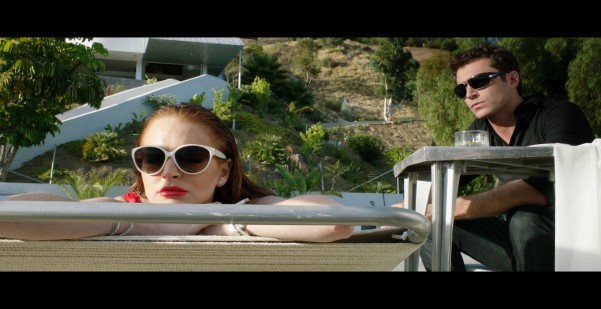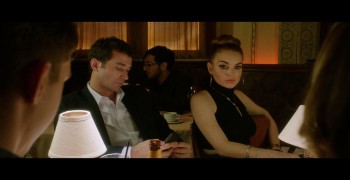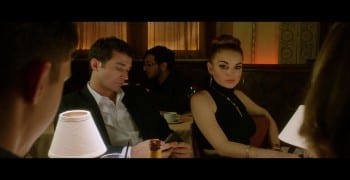
Lindsay Lohan and James Deen in ‘The Canyons,’ directed by Paul Schrader
What do you get when you pair Paul Schrader, one of the darkest directors when it comes to raw sexual issues on screen, with gay novelist Bret Easton Ellis, who specializes in creepy dark comedies about soulless 20somethings obsessed with sex and power … then add in Lindsay Lohan? The answer is The Canyons, a new film available through the growing Video On Demand platform.
The film — intended as a kind of comeback for Lohan, and an attempt at mainstream appeal for straight porn actor James Deen — deals with young, amoral Los Angelenos involved in sex games in between their work in the corners of the movie industry.
I chatted with Paul Schrader — who first came to Dallas in 1971 for the USA Film Festival (as a film critic, not a filmmaker) — about the lurid themes of the film, the changes in the movie industry and working with Lohan.
The Canyons is now available VOD on iTunes, Goggle Play, Xbox, Playstation, YouTube, Amazon and cable.
Dallas Voice: How has your background as a film critic informed you as a filmmaker? Paul Schrader: Not necessarily to the good. A film critic is like a medical examiner — he wants to open the cadaver and see how it lived. A filmmaker is like a pregnant woman — she wants to do anything to protect that baby. So you’d better be careful letting the critic into the operating room, cuz he will kill that baby.
Has VOD changed filmmaking? I think it will [change the industry]. You can watch any movie on whim. We’re just seeing it come about now. [The Canyons] was a film designed to be released on-demand; it was not because it flopped in theaters. This is cinema for the post-theatrical era — that’s why [you see so many shots] of all those dead theaters.
Speaking of dead theaters, this movie has an aura of an insider’s disgust with Hollywood — sort of like Nathaniel West’s The Day of the Locust … Kids are making movies who don’t even like movies very much. That’s not Nathaniel West, that’s the post-porn apathy. I told my cast when we started, “This is a story about 20something Angelenos who went to see a movie, but the theater closed and they stayed in line anyway.”
Are you frustrated by movies nowadays? I often find myself looking at the screen and thinking, “How did [the actors and crew] stay awake while making this movie?” Because every one of them has made the same thing five times before. What did they do, stick a pin in their [skin] to wake up?
 The movie has a definite anti-movie attitude. Is that more you or Bret? It’s Bret’s story. Bret was my partner so I wasn’t going to screw around with it too much. I think it’s more Bret [in the film] than me, he thinks it’s more me than him. I guess that’s the mark of a good collaboration. But I do think it’s his world.
The movie has a definite anti-movie attitude. Is that more you or Bret? It’s Bret’s story. Bret was my partner so I wasn’t going to screw around with it too much. I think it’s more Bret [in the film] than me, he thinks it’s more me than him. I guess that’s the mark of a good collaboration. But I do think it’s his world.
It has a lot of your interests, though; I’m thinking especially American Gigolo. It has a similar rhythm to Gigolo — talk talk talk, then walk walk walk.
It’s a film about shallow people, but even their shallowness doesn’t mean they are without feelings. You sometimes feel bad for them. The human desire to empathize is such that if you watch someone long enough, you like them.
Like Norman Bates … Like Travis Bickle.
There are a lot of themes in The Canyons, among them, “Money can’t buy happiness — but it does buy almost everything else.” Yeah, I mean this is interesting. Patrick Bateman [the anti-hero of Bret Easton Ellis’ American Psycho] was the “let’s make money” generation. And this is the “let’s make money and not have fun doing it” generation.
If I had to pick one line that states the main thesis, it would be when Christian (James Deen’s character) says, “Nobody has a private life anymore, Tara.” Yes, that was interesting to Bret. I’m a generation away from Bret, and the characters in the film are a generation away from Bret, but he knows them. It’s the Grindr generation.
 One overlap is how the film uses sex as a weapon, which you see in your films and Bret’s writing. Yeah, but Bret’s world-view is a little colder than mine.
One overlap is how the film uses sex as a weapon, which you see in your films and Bret’s writing. Yeah, but Bret’s world-view is a little colder than mine.
How did you get Gus Van Sant to act in it? Well you know, when you’re only paying people $100 a day, you ask your friends. I asked Willem Dafoe and Michael McKean, but they couldn’t do it. So I turned to the producer and said, “Who are your friends?” And that’s how we got Gus.
The film has a very guerrilla-style, handheld look, with ambient sound. Is that new for you? Was it your plan? In the new film language, you can put a Bertolucci next to a Haneke scene and the viewer will weave it together. The best scene for Lindsay is when she comes in a little drunk and she’s ragging on James. It’s all handheld, but [originally] we had it all blocked out and [were ready to do it conventionally]. Then there was some altercation where [Lindsay] took off and we didn’t know if she was going to finish [the shoot]. When she came back, I said to my DP, “This is like fucking reality television; let’s shoot it like reality television and see what happens.”
The New York Times did a 6,000-word story on the making of the film, including casting adult film star James Deen and even giving the troublesome Lindsay Lohan another shot. What did you think of that piece? Well, Lindsay kind of hijacked it, which is what she tends to do. For a micro-budget film, you need to make some noise or people won’t know you’re there. Putting Lindsay and James together, and putting me and Bret together, and bringing in the New York Times … we have been sowing the wind.
















